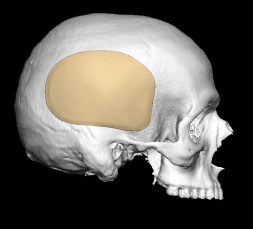How Much Thickness Do I Need For My Custom Temporal Head Widening Implants?
Q: Dr. Eppley, I am interested in custom temporal implants for head widening. My questions are:
1) Do you factor in the implant’s design the amount of postoperative swelling that will occur?
2) What is the usual thickness of head widening temporal implants?
3) Can you make an implant design and then show me what it will look like on myself?
4) Can I see before paying for the surgery what my implant design would look like?
5) Can you predict how much temporal fullness will be lost when the swelling subsides?
6) Can I connect the previously placed custom skull implant on the top of my head with these new custom head widening temporal implants?
7) how can I be assured that after the swelling subsides I will have the head widening amount that I want?
 A:I can answer all of his questions in advance of our virtual consultation.
A:I can answer all of his questions in advance of our virtual consultation.
1) Since these are custom implants they can be designed with any thickness dimensions as long as they can fit or be surgically placed. For the purposes of factoring in the effects of postoperative swelling one simply has to guess how many more millimeters that would be an implant thickness. There is no exact science as to how to factor in for postoperative swelling. To me what that means is maybe an additional 2 mm of thickness.
2) Since these implants would be submuscular a safe temporal with is 5 to 7 mm maximum.
3) There are no tools to accurately show people what their postoperative results may be. All we can do is use preoperative Photoshop to determine the patient’s goals. Ai is not going to be helpful as is there is no database of information about the effects of implants on an external appearance.
4) The only method to show a 3D implant design/rendering is to actually engage the implant design process with 3D Systems. They are the company that does all of that implant designing but they don’t do so until they are paid.
5) There is no known method to tell you how much fullness will be lost after the swelling subsides.
6) You can always in the future add volume to the front or back of your head with additional implants, that is not an issue and can easily be done with additional implant designs. The problem is if you try to connect the front or back to the sides where the implant must sit above the muscle on top of the fascia where implant edging and chronic fluid collections are real postoperative possibilities.
7) There are no strategies for maintaining postoperative width fullness. You pick a number that you want the implant to be and you hope when it is all done and said that it largely achieved what your with desires are.
Dr. Barry Eppley
World-Renowned Plastic Surgeon

North Meridian Medical Building
Address:
12188-A North Meridian St.
Suite 310
Carmel, IN 46032
Contact Us:
Phone: (317) 706-4444
WhatsApp: (317) 941-8237
